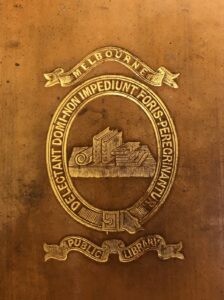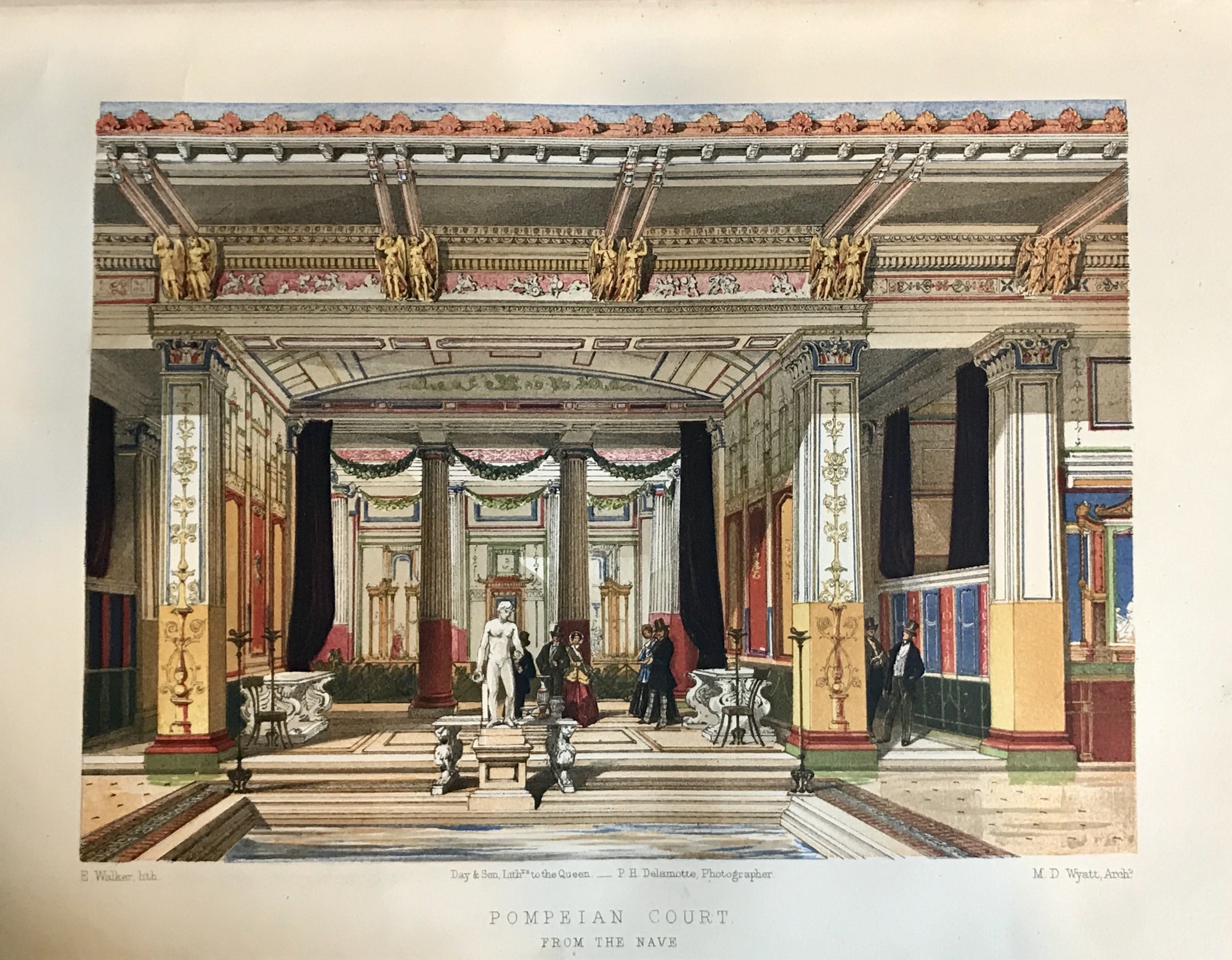Wyatt Views of the Crystal Palace (1854), Plate 1: Pompeian Court
Introduction
Redmond Barry’s enthusiastic engagement with the formation of the collection of books and periodicals in the Melbourne Public Library [MPL] is well documented, and the subject of a number of suitably laudatory interpretations. The scope of his initial recommendations is seriously impressive, covering not only predictable topics such as classical civilization, British history, literature, law etc., but also a variety of other areas of the arts and sciences, indicating a considerably more adventurous and wide-ranging world-view than one may have anticipated.
By 1870, the Library’s collection was estimated to number well over 50,000 volumes (see AR 1870-71, p.13). And even in its first decade of purchasing, the MPL’s program of acquisitions of books and periodicals was remarkable. This included a significant group of 17th to 19th-century illustrated volumes, the most notable of which are catalogued here, and a substantial number of other books on art, architecture, archaeology and travel, listed in Appendix: Other significant books acquired for the Melbourne Public Library to 1861.
Initial attention is given here to illustrated books acquired up to 1861 (as recorded in the detailed catalogues published in 1854, 1857 and 1861). The longer-term aim is to develop a comprehensive catalogue extending through to 1904, to reflect the full range of Melbourne’s acquisitions in this important field prior to the commencement of the Felton Bequest. In more recent times, it should be noted, a number of other illustrated books, including some of these titles, as well as others by William Blake and others, have been acquired for the NGV.
***
Amongst the notable early acquisitions of illustrated books for the MPL were several rare and important 17th and 18th-century volumes of engravings on architectural and archaeological topics, such as Campbell Vitruvius Britannicus 1715ff. {1860} SLV [IB], a spectacular 5-volume survey of English architectural developments from the late 16th to 18th centuries.
Engraving and etching continued to be used for the illustrations of a number of 19th-century volumes also listed here. Other significant acquisitions in this category were several books of engravings after John Flaxman’s line drawings after Homer, Dante and others, identified soon after their creation in the early 1790s as key innovations in the development of both graphic art and the relationship between art and poetry in the Romantic era. For further discussion, see individual entries and the linked entry on Flaxman.
Also noteworthy among the early acquisitions were several books produced by Gothic Revival architect and polemicist Augustus Welby Pugin and his father A.C.Pugin. A.W.Pugin illustrated his books with both line-engravings and chromo-lithography based on his own drawings.
Melbourne’s early purchases of illustrated books also included a number of key volumes documenting the developing tastes of the Victorian era, as exemplified by major exhibitions of the period, including the Great Exhibition (1851), the various displays of the rebuilt Crystal Palace at Sydenham (1854), and the Manchester Art Treasures exhibition (1857). In each case, the relatively recently perfected technique of chromo-lithography was used to provide vivid and often highly precise reproductions produced by Francis Bedford and other skilled printmakers of the period. Melbourne’s acquisitions included several volumes still regarded as benchmarks for the medium of chromo-lithography: see Pugin (A.W.) Ecclesiastical Ornament & Costume 1846 {1857} SLV [IB] and Jones (O.) The Grammar of Ornament 1856 {1857} SLV [IB].
Colour lithography was also fundamental to other important illustrated volumes listed here. Notable in this respect were several 1840s books of illustrations of classical Indian architecture by James Fergusson; and the spectacular 7 large-format volumes of Gould Birds of Australia 1848 {1856} SLV [IB], whose purchase was negotiated with the artist directly by Barry himself in 1856 (after having identified Gould’s books in his first list of desiderata as early as 1853: see Overell 1997).
The great majority of the volumes listed below still remain in the collection of the SLV, testifying to an extraordinary first phase of purchasing of key illustrated books, in the years preceding the first acquisitions of other original artworks for the Melbourne collection.
***

[photo: MPL stamp from the cover of an early acquisition]
Individual Entries
Adam (R.) & others Palace of Diocletian 1764 {by 1861} SLV [IB]
Adams (E.) Polychromatic Ornament of Italy 1846 {by 1861} SLV [IB]
Bartoli Colonna Traiana (1673) {by 1861} SLV [IB]
Becker Men of Victoria 1856 {by 1861} SLV [IB]
* British Museum: Ancient Marbles 1812-45 {1859} Loc? [IB]
* Bunyan Pilgrim’s Progress 1840 {1857} Loc? [IB]
Campbell Vitruvius Britannicus 1715ff. {1860} SLV [IB]
Claude Lorrain (after) Liber Veritatis 1777 and 1819 {1858} SLV [IB]
Fergusson Rock Cut Temples of India 1845 {by 1861} SLV [IB]
* Fergusson Ancient Architecture in Hindostan 1848 {by 1861} Loc? [IB]
Flaxman (after) Compositions from the Iliad of Homer 1805 {1857} SLV [IB]
Flaxman (after) Compositions from the Odyssey of Homer 1805 {1857} SLV [IB]
Flaxman (after) Compositions from the Divine Comedy of Dante 1807 {1857} SLV [IB]
Flaxman (after) Compositions from Hesiod 1817 {1857} SLV [IB]
Flaxman (after) Compositions from the Tragedies of Aeschylus 1831 {1857} SLV [IB]
Flaxman (after) Compositions of the Acts of Mercy 1831 {1857} SLV [IB]
Flaxman (after) Anatomical Studies 1833 {1857} SLV [IB]
Gell Pompeiana 1832 {by 1861} SLV [IB]
Gould Birds of Australia 1848 {1856} SLV [IB]
Hogarth Illustrated (ed.Ireland) 1793-1804 {1857} SLV [IB]
Hogarth Works 1822 {1857} SLV [IB]
Humphreys & Jones (O.) Illuminated Books of the Middle Ages 1849 {1860} SLV [IB]
Jones (I.) Designs 1727 {1860} SLV [IB]
Jones (O.) Designs for mosaic and tesselated pavements 1842 {by 1861} SLV [IB]
Jones (O.) & Goury Alhambra 1842-45 {1858} SLV [IB]
Jones (O.) The Grammar of Ornament 1856 {1857} SLV [IB]
* Lassus & Viollet-le-Duc Notre-Dame de Paris 1856 {1859} Loc? [IB]
Lear Journals of a Landscape Painter in Southern Calabria 1852 {by 1861} SLV [IB]
Palladio Fabbriche/Terme 1785-6 {by 1861} SLV [IB]
Pugin (A.C.) & Britton Public Buildings of London 1838 {1858} SLV [IB]
Pugin (A.C.) Ornamental Timber Gables 1839 {1857} SLV [IB]
Pugin (A.W.) Contrasts 1836 {1857} SLV [IB]
Pugin (A.W.) Details of Antient Timber Houses 1836 {1857} SLV [IB]
Pugin (A.W.) Ecclesiastical Ornament & Costume 1846 {1857} SLV [IB]
Pugin (A.W.) Floriated ornament 1849 {1857} SLV [IB]
Reynolds (J.), after: Engravings 1820 {1858} SLV [IB]
Ruskin Stones of Venice 1851-53 {1857} SLV [IB]
Stanfield (after) Coast Scenery 1836 {1861} SLV [IB]
Vitruvius (trans.Wilkins) 1812 {1858} SLV [IB]
Waring Manchester Art Treasures 1858 {1858} SLV [IB]
Wilson Works (etchings by Thomas Hastings) 1825 {1858} SLV [IB]
Wood (R.) Ruins of Palmyra & Balbec 1753 & 1757 {by 1861} SLV [IB]
Worlidge Antique Gems 1768 {1858} SLV [IB]
Wyatt Industrial Arts of the Nineteenth Century 1853 {1861} SLV [IB]
Wyatt Views of the Crystal Palace 1854 {1859} SLV [IB]
Refs.
For Redmond Barry’s early recommendations and purchases of books, see in particular David McVilly, “The acquisitions policy of the State Library of Victoria, 1853-1880,” La Trobe Journal no.7 (April 1971), pp.57ff. (available online); and Overell (1997).
For information on the original motto, and the revised 1870 seal (with a quote from Virgil), see https://guides.slv.vic.gov.au/slvhistory/motto (accessed 3 Feb.2021), based on the extended discussion by Brian Hubber, “Leading by example: Barry in the Library,” La Trobe Journal no.73 (Autumn 2004), pp.67-74


